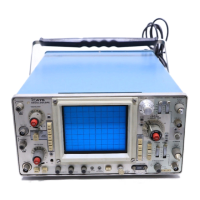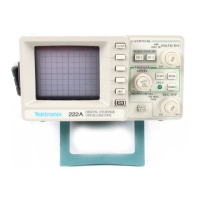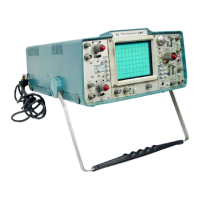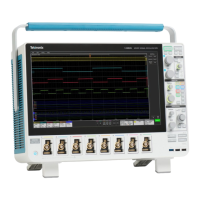Servicing
Information— SC 501
Z-AXIS
AND CRT
CIRCUIT
DESCRIPTION
Z-Axis
Amplifier
and
+
Gate Out.
The Z-axis amplifier is
a
shunt-feedback
operational
amplifier with
a
voltage
output.
The
amplifier consists of
Q336, Q348,
and Q345.
The
feedback path is
from the collectors
of
Q345-Q348
through C339-R339
to
the
summing point at the base of
Q336.
Q345 and Q348
are connected as
a
complementary
amplifier to provide a
fast
risetime signal
while
consuming
minimum
quiescent power. Q345 acts as a
pull-up
transistor
and
Q348
acts
as
the
pull-down transistor for the amplifier.
The
output voltage
from the
amplifier provides
the
drive
signal
to
control the
crt intensity
level
through the
control-grid supply.
Emitter-follower
Q315,
acts as
a
buffer
amplifier
for the
Z-axis
amplifier
and
+
Gate Out
circuits.
The negative-going
unblanking gate
at
the
emitter
of Q315
is
coupled
through
CR334 to
the Z-axis
amplifier.
The
current through
CR334
is set
by
R330,
INTENSITY control.
When R330
is set to
+20
V,
CR334
is cut
off and the
crt is
blanked.
Cathode-Ray
Tube
Circuit.
A
repetitive, sinusoidal
signal
is
produced
by a
regenerative feedback oscillator in the
primary
of
T380
and
induced
into
the secondary. Current
drive for
the
primary
winding
is
furnished
by
Q380,
whose
conduction
is controlled
by
the voltage
difference between
its base
and emitter. The secondary
winding
of
T380
develops
about 350
volts peak-to-peak. The sextupler rec-
tifier
circuit (six
diodes in series) produces about
—980
V
dc at
the
crt
directly-heated cathode
(filament).
A
separate
transformer tap
and
rectifier
circuit,
CR382,
in
the
second-
ary
of
T380 produces
about
-t70
V
dc
for the vertical,
horizontal, and Z-axis
amplifiers.
The 350
volts
peak-to-peak
output
of
T380 is also
applied to CR415 and
CR416
to
provide the rectified
negative potential for the crt control
grid. CR420
limits
the
positive swing with respect to the
-t
dc
reference level
set by
Bias
adjustment
R425. CR418 limits the negative swing
with respect to the output voltage level of the
Z-axis
amplifier.
R410
connects the
crt
grid voltage
to
the crt
filament (cathode)
to
ensure
that the crt grid is
more
negative than —980
V
(crt is
cut
off).
A
positive-going
unblanking gate from the Z-axis amplifier
decreases crt bias
and
intensifies the
trace.
High voltage
regulation is accomplished
by
sampling the
—980
V
across
a
voltage
divider
returned
to
-t-20
V
(five
1
resistors
in series with
R362). A quiescent
level
of
zero
volts is established
at
the
base of
Q365,
a
Darlington
amplifier.
If
the
output
level
of the nominal —980
V goes
more
negative,
the
output
level of
Q365
goes
more
positive,
reducing the
conduction of
Q370 and
Q380.
The
result is a
lower
peak-to-F>eak
amplitude
induced in the
secondary of
T380.
Conversely, if
the
—980
V goes
more
positive,
Q380
will conduct harder
and
a
larger
peak-to-peak voltage
appears across the secondary of
T380.
C367
limits
the
regulator bandwidth
to
prevent
oscillations.
Q360
and
Q350,
and
associated components, is
a
high
voltage
shut-down circuit.
If
the
-t70
V or
—980
V supplies
increase above the amplitude regulation
limits, Q360
will
turn on, reducing the voltage difference between the
base
and
emitter of
Q380 to
near zero
and removes
the
current
drive
to
the primary
of
T380.
